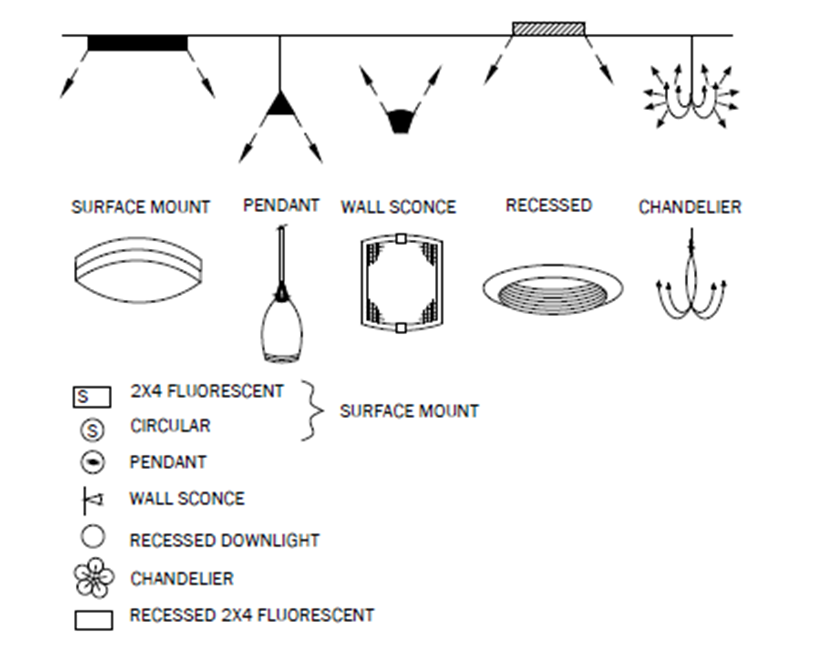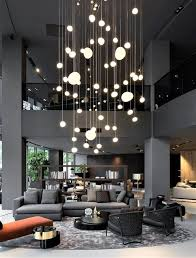Week 9: Electrical Systems and Lighting
- Power companies provide electricity for most buildings.
- they are generated by several sources but the biggest source of energy used in a building is electric lighting.
- Electricity travels from the utility company to the user through overhead and underground electrical lines or transformers
- Components of electrical systems consist of:
- Connection to a building
- Cable types
- Electrical symbols
- Energy management devices
- Keeping buildings well-insulated and lowering the thermostat temperature
- lighting control devices
- motion and daylight sensors
- Dual switching option
- Good lighting design impacts energy efficiency and the ultimate sustainability of a building.
- the most common mistake is to overlight a space. the less lighting used, the less air conditioning is needed since lighting creates a big heat load.
- The behavior of light depends on the material of the surface, light may be reflected, refracted, transmitted, diffused, or a combination of the above.
- People perceive different levels and types of lighting
- Good lighting improves worker performance and control over lighting increases employee satisfaction
- Incandescent, fluorescent, high-intensity discharge, and light-emitting diodes are the implications of a lamp
- Incandescent
- Primarily used in residential applications
- It is warm in appearance
- Dimmable
- Inexpensive
- It does contain the issues of being inefficient and giving off more heat than light.
- Halogen
- type of incandescent light
- warm-white appearance
- strong focused beam of light
- used to illuminate display items and artwork
- Fluorescent
- used mainly in commercial applications
- energy efficient
- economical
- the disposal of lamps introduces mercury to landfills which is a sustainability issue
- Light emitting diodes (LED)
- Introduced recently as an energy-efficient solution to interior lighting
- research on LED lighting is still going
- long-lasting
- concerns over color consistency
- Color
- Correlated Color Temperature (CCT
- Color Rendering Index
- Chromaticity Chart
- Fixture types
- Cut Sheets
- Manufacturers provide cut sheets for their light fixtures
- these include information about
- construction of fixtures
- electrical requirements
- available finishes
- lamp requirements
- size
- operation
- Lighting metrics
- Photometry
- luminous flux is the time rate flow of light
- luminous intensity is the directional force causing the luminous flux to be emitted
- illuminance is the density of luminous flux incident at a point on a surface
- luminance is the luminous intensity of a source in a direction divided by the area of a source
- luminous exitance is the density of luminous flux leaving a surface in all directions at a point.
- Designing with light process
- identify the spaces and the tasks
- verify the number of foot candles
- select the best lamp type
- select luminaire consistent with design
- do lumen calculations
- Analyze daylight in the space and the need for artificial lighting
- create a solution for handling and managing daylight
- do lighting layout
- create a 3D model of lighting to study distribution
- design special lighting effects
- use a reflected ceiling plan















Amazing job, it was very thorough and your pictures were great! I love the pictures that you chose for your blogging assignment! I wish your drawing was oriented the right way, but the shadows portrayed is well done!
ReplyDeleteYour drawing is great! Also you summarize very well on this chapter. There was a lot of information and you made it clear and easy to read.
ReplyDeleteI like how you kept your summary in bullet points. It was very easy to keep track of the main points. I also really like your sketch. I think you captured the shadows very well.
ReplyDeleteI really liked your summary, and the images helped to understand the material better.
ReplyDeleteEli-
ReplyDeleteThis was a well organized and thorough presentation of the information we looked at this week. I appreciate how you introduced this section with information about electrical systems and symbols. You then proceeded to discuss the effects of lighting on humans and performance issues. You gave us helpful summaries of each type of lighting and fixtures. The final summary included a reflected ceiling plan. Your sketch was excellent and the two examples of quality lighting solutions were perfect. 50/50 points